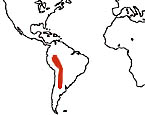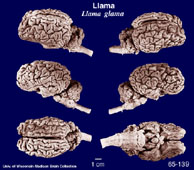|
Llama
(Lama glama) #65-139 |
||||
|
|
Physical
characteristics and distribution
|
|
Llamas (Lama glama), along with Alpacas, are domesticated descendants of Guanacos (Lama guanicoe). Llamas have long shaggy coats that vary in color from white all over through spotted or speckled, to brown, black, or red all over. Their head and body length ranges from 1,200-2,500 mm, height at the shoulder from 900-1,300 mm, and they may weigh from 130-155 kg. Llamas move gracefully; they are capable of carrying a load of 96 kg. Llamas are grazers as well as browsers, eating on grasses and forbs. The social structure is such that llamas tend to live in small groups of 7-16 individuals with a dominant male having a harem of females. Included in the groups are young that are no older than 13 months. Though some females and their young form their own sub-groups in the winter, the male defends all the whole territory from other males as well as predators. Breeding occurs in the spring. Females give birth to a single young after a 10-month gestation period. Male and female young are forced to go out on their own by the dominant male when they are 13-15 months old. The males spend 3-4 years in bachelor groups where they compete for dominance by fighting by ramming their necks and chests against one another. Llamas are located from southern Peru to northwestern Argentina. They inhabit mountains and upland plateaus at altitudes of more than 10,000 feet. |
|
Description
of the brain
|
|
Animal
source and preparation
|
|
All
specimens collected followed the same preparation
and histological procedure.
|
Other
Related Resources (websites and publications)
List of Specimens | Explore Collections | Brain Sections | Brain Evolution | Brain Development | Brain Circuitry | Brain Functions | Location and Use | Related Web Sites | Contact Us | Search MSU Database | Personnel | Home



